EMEA SPC WPC installation
I. GENERAL INFORMATION
All instructions and recommendations should be followed for a satisfactory installation.
-
Acclimation of material prior to installation is not required however the floor covering should be installed in a climate controlled environment with a temperature between 18°C-27°C as per BS8203.
-
Post installation temperature range is between 13°C- 37.7°C.
-
Avoid exposure to direct sunlight for prolonged periods, doing so may result in discoloration. During peak sunlight hours the use of the drapes or blinds is recommended. Excess temperature due to direct sunlight can result in thermal expansion and UV fading.
-
Install product after all other trades have completed work that could damage the flooring.
-
To minimize shade variation, mix and install planks from several cartons.
-
Inspect all planks for damage before installing. If you have any concerns about the product fit or finish, call Shaw Contract EMEA tel: +44 (0) 20 7961 4120. Claims will not be accepted for flooring that has been cut to size and/or installed.
-
Use of cementitious patching and leveling compounds that meet or exceed maximum moisture level and pH requirements and meet or exceed the compressive strength of 20 N/mm squared (3,000 psi) are acceptable.
-
Installation Methods: Loose laid or fully bonded (on, above or below grade)
-
For installation in areas larger than 16m x 16m (256 sqm) provide a minimum expansion space of 13 mm around the perimeter. Smaller areas must have an expansion space of 6mm expansion gap.
-
Correctly places seams are deemed to be resistant to moisture ingress from above.
-
Should the base be found to be damp or have a moisture vapor content higher than 75% RH an additional layer of suitable Visqueen vapor retarder, 6 mil poly film or equal vapor retarder with a perm rating of 1 or less may be used as an additional layer of protection.
II. SUBFLOOR INFORMATION
All subfloors must be clean, flat, dry and structurally sound. The correct preparation of the subfloor is a major part of a successful installation. Subfloor must be within a surface deviation of no greater than 5 mm under a 2 metre straight edge (Surface Regularity 2 (SR2) – BS 8203/BS 8204).
A. WOOD SUBFLOORS
Do not install material over wood subfloors that lay directly on concrete or over dimensional lumber or plywood used over concrete.
-
Do not apply visqueen or polyfilm over wood subfloors.
-
Basements and crawl spaces must be permanently dry. Where necessary, local regulations prevail.
-
All other subfloors - Plywood, OSB, particleboard, chipboard, wafer board, etc. must be structurally sound and be installed following their manufacturer’s recommendations. Local building codes, national standards and manufacturer’s recommendations may only establish minimum requirements of the flooring system and may not provide adequate rigidity and support for proper installation and performance. Plywood should be of a suitable flooring grade, be at least 6 mm thick and conform to all relevant country applicable regulations and standards..
-
The responsibility of determining if an existing flooring finish is suitable to be installed over rests solely with the installer/flooring contractor on site. If any doubts exist in relation to the suitability of such a base, serious considerations should be given to it’s full removal and it’s subsequent repair.
B. CONCRETE & sand cement SUBFLOORS
-
Floors shall be smooth, permanently dry, clean, and free all foreign material such as dust, wax, solvents, paint, grease, oils, and old adhesive residue. The surface must be hard and dense, and free from any substance to impede adhesion.
-
Cementitious based substrates should have a country applicable moisture vapor content that is deemed dry enough to lay resilient floor finishes upon. The ‘British Standard 8203’ requires surface hygrometer readings to have reached equilibrium and be below 75% Relative Humidity (RH). The ‘ASTM F1869’ states a maximum moisture level per the CaCl test method of 8 lbs. per 1000 in a 24 hour period.
-
Do not install over concrete with a history of high moisture or hydrostatic conditions. Excessive moisture in the subfloor could promote mold, mildew, and other moisture related issues like the trapping of moisture emissions under the flooring, which may contribute to an unhealthy indoor environment. Shaw Industries does not warrant nor is responsible for damage to floor covering due to moisture related issues.
-
pH level of concrete should be between 7-10.
-
The final responsibility for determining if the concrete is dry enough for installation of the flooring lies with the floor covering installer.
NOTE: IT MAY NOT BE THE FLOOR COVERING INSTALLER'S RESPONSIBILITY TO CONDUCT THESE TESTS. IT IS, HOWEVER, THE FLOOR COVERING INSTALLER'S RESPONSIBILITY TO MAKE SURE THESE TESTS HAVE BEEN CONDUCTED, AND THAT THE RESULTS ARE ACCEPTABLE PRIOR TO INSTALLING THE FLOOR COVERING. WHEN MOISTURE TESTS ARE CONDUCTED, IT INDICATES THE CONDITIONS ONLY AT THE TIME OF THE TEST.
C. LIGHTWEIGHT CONCRETE & ANHYDRITE (GYPSUM) BASED SCREEDS
All recommendations and guarantees as to the suitability and performance of lightweight concrete and anhydrite (gypsum) based screeds under resilient flooring are the responsibility of the supplier / manufacturer. The installer of the system may be required to be authorized or certified by the manufacturer. Correct on-site mixing ratios and properly functioning pumping equipment are critical. To ensure proper mixture, slump testing is recommended.
-
Surface must be permanently dry, clean, smooth, free of all dust, and structurally sound.
-
As with all bases, Relative Humidity (RH) moisture tests should be conducted prior to undertaking any flooring works. Materials should have a country applicable moisture vapor content that are deemed dry enough to lay resilient floor finishes upon. The ‘British Standard 8203’ requires surface hygrometer readings to have reached equilibrium and be below 75% Relative Humidity (RH). The ‘ASTM F1869’ states a maximum moisture level per CaCl test method of 8 lbs. per 1000 ft2 in a 24-hour period.
-
Bond testing to determine compatibility of adhesive to the substrate is advised. Primer can be utilized to promote adhesion.
D. RADIANT UNDERFLOOR HEATING: WET / HYDRONIC ONLY
In most instance wet or Hydronic underfloor heating systems are installed below sand cement / Anhydrite screeds that have been laid to a depth somewhere between 50 to 75 mm thickness.
It is imperative that the underfloor heating system has been previously commissioned and found to be fully functioning correctly prior to any part of the resilient floor coverings package being installed upon the base's surface. The underfloor heating system must be switched off for at least 48 hours prior to commencement of works and must remain off for a further 48 hours after the installation has been completed. It is also important to note that whilst the underfloor heating system has been decommissioned, an alternative heating source should be provided to ensure that the area of installation is kept at a constant temperature of between 18 °C and 27 °C.
After this 48-hour period, the underfloor heating system can be gradually recommissioned in accordance within standard industry recognized rules. Once operational, it is important to note that the heating system must not exceed the industry agreed maximum operating temperature of 27 °C at the underside of the floorcovering (the adhesive line).
In areas where the use of a higher temperature is unavoidable, agreement from your chosen adhesive manufacturer should also be obtained.
Failure to follow the aforementioned guidelines can result in floor finishes and their associated systems being irreversibly damaged.
E. EXISTING FLOOR COVERINGS
-
Loose lay / interlocking type floor finishes can in most instances be installed over most existing hard-surface type floor coverings, provided that the existing material is fully adhered, is clean, flat, dry, structurally sound and free of deflection or material that could have an adverse effect on the installation. Existing sheet vinyl floors should not be heavily cushioned and not exceed more than one layer in thickness. Soft underlayment and soft substrates will compromise products with an interlocking ability as well as diminish indentation resistance.
*NOTE: Resilient floor finishes that require fully bonding in most instances should NOT be installed over existing floor finishes.
-
Installation of any floor finish is NOT allowed over any type of carpet.
-
Do NOT install over wood floors that are adhered to concrete.
-
Solvent residue left in and on the subfloor may have a negative effect upon newly installed floor finishes and their subsidiary underlying systems. Never use solvents or citrus adhesive removers to remove old adhesive residues.
F. RAISED ACCESS PANEL SUBFLOORS
-
60 cm x 60 cm panels are recommended.
-
Raised access panels must be stable, level, flat, free and clean of existing adhesives.
-
Where / if necessary, repair or replace any loose or unstable panels.
-
Lippage (variation of height) between of panels must not exceed 0.75 mm gaps between panels must not exceed 1 mm.
-
There should be no deflection of the individual panels – Concave less than 0.75 mm.
-
The surface of the system must be flat and level within a surface deviation of no greater than 5 mm under a 2.0 metre straight edge.
-
Should access to the underside of the raised access base be a requirement, allow for framed inspection type hatches.
-
Use the appropriate installation methods for the product. Loose lay / interlocking type floor finishes that are being installed directly upon such panels must have their joint lines staggered so that they do not coincide with those found on the raised access system.
-
It is important to note that the joints of raised access bases can sometimes be physically viewed grinning back through the entire thickness of resilient floor finishes. Such disparity is not considered to be a product defect.
*NOTE: Should any doubt exist concerning the suitability of the raised access base, such surfaces can be covered with a 6 mm thick flooring grade plywood. Self-tapping screws, ring shank nails or divergent staples can be used to fix the boards. Should there be slight undulations or differences in height observed in the plywood sheets, a thin coat of a suitable flexible flooring / board grade feathering underlayment can be applied to the plywood’s facade prior to installing the floor finishes up on its surface.
III. INSTALLATION
Tools: Tape Measure, Utility Knife, Jigsaw, Tapping Block or Rubber Mallet, Pull Bar, 6 mm Spacers, T-Square, Safety Glasses, Broom or Vacuum and, if necessary, tools for subfloor repair.
Floating Installation: Rigid Core plank flooring is designed to be installed utilizing the floating method. A proper expansion space of 6.0 mm is required. Undercut all doorjambs. Do not fasten wall moldings and or transition strips to the planks.
Glue Down Installation: Rigid Core products are approved for glue down installation over approved wood and concrete substrates. It is still important to maintain a 6 mm perimeter expansion space. Follow adhesive label application instructions. Install flooring into semi-wet adhesive. Roll the flooring immediately after installation with a heavy duty, 50 kg, flooring grade segmented roller
NOTE: Recommended Adhesives are available from F. Ball and Co, Mapei, Uzin, Thomsit, Tremco, Schonox, Bostik or comparable adhesive. Always follow adhesive label application instructions.
Tile patterns must be installed in a staggered (offset) brick pattern. Minimum 1/3 offset 1/2 offset is preferred.

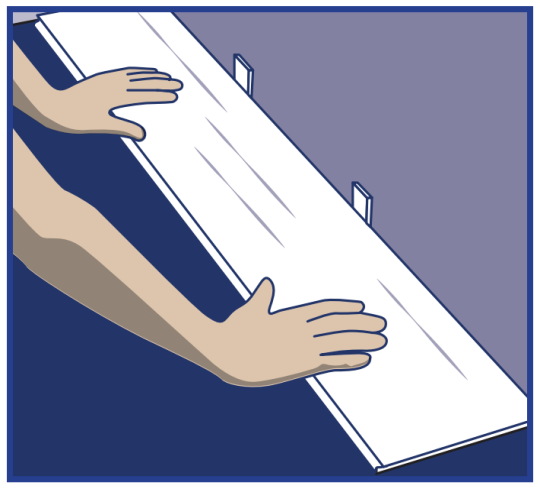
Step 1: Begin installation working from left to right. Insert spacers at ends and edges where planks meet wall. |

Step 2: Lock short end of plank by inserting tongue into groove at an angle and drop in place. Continue to end of first row. |
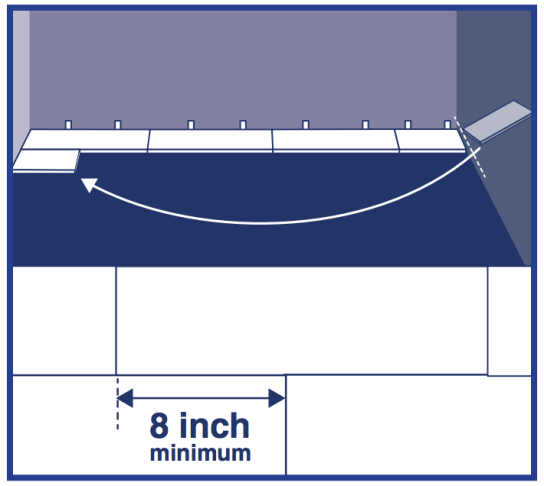
Step 3: Use leftover plank from first row as starter for second row. There must be at least 20cm between plank end joints on adjacent rows. FOR TILE INSTALLATIONS: The distance between end joints should be equal to 30cm for proper appearance. |
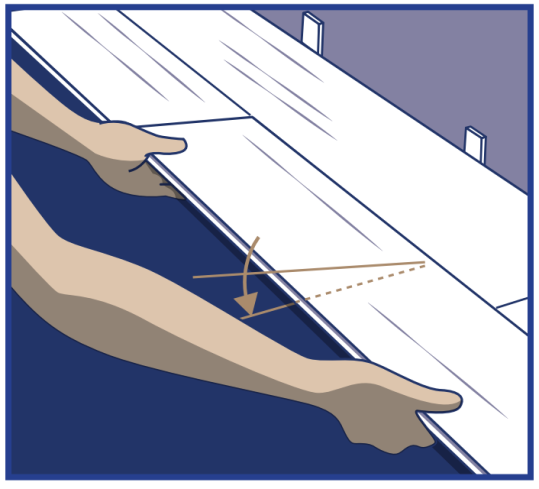
Step 4: Lock long edge of plank by inserting tongue into groove at an angle and drop in place. Slide plank toward end of previously installed plank until the tongue just touches the groove. |
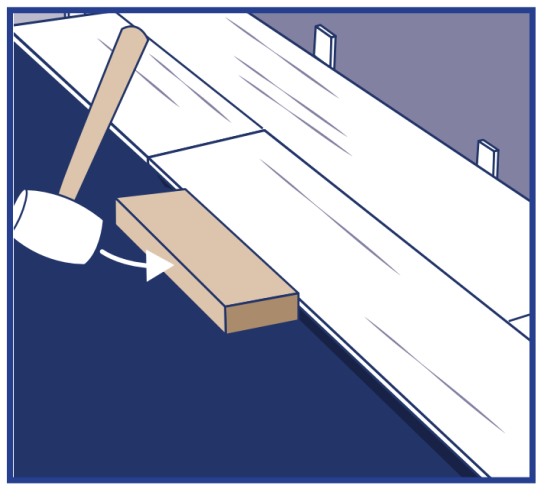
Step 5: IMPORTANT! Use hammer and tapping block to tap long edge of plank to ensure a tight fit. ANY GAPPING CAN COMPROMISE THE LOCKING SYSTEM! |
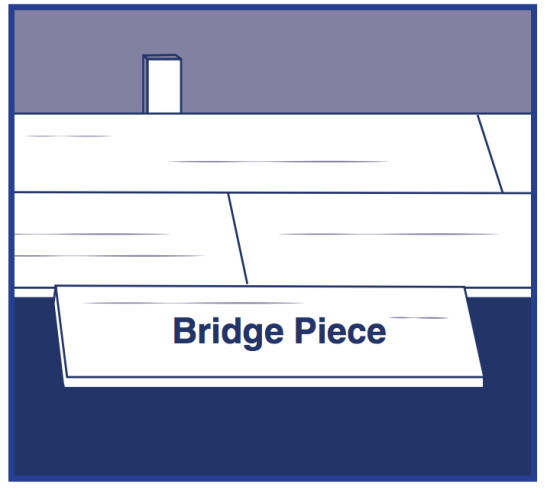
Step 6: Attach a scrap piece of floor to bridge the gap between ends of planks. |
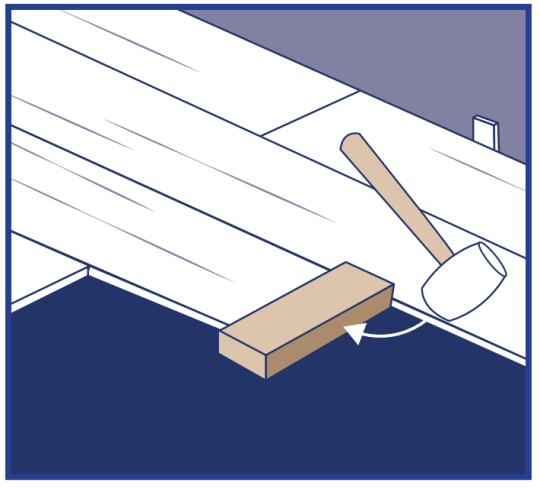
Step 7: Tap end of plank with hammer and tapping block to lock ends of planks together. Remove bridge and continue towards wall until installing the final plank in the row. BE SURE TO TAP ON EDGE OF VINYL SO AS NOT TO DAMAGE LOCKING PROFILE. |

Step 8: Use hammer and pull bar to lock final piece in row. Insert spacer at end of row. Continue installation to final row. |
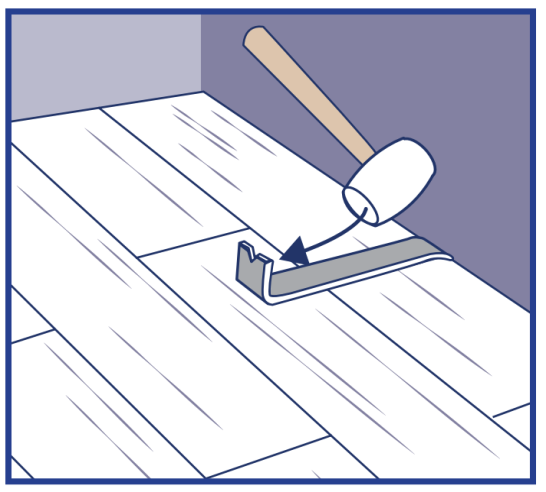
Step 9: Use hammer and pull bar to lock long edges of planks on final row. |
|
| Installing underneath door jambs: |
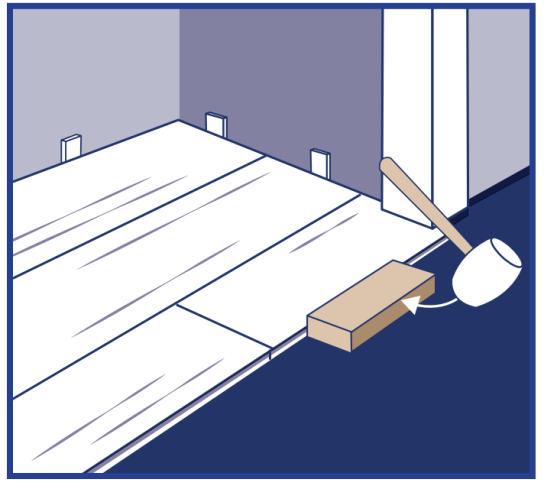
Step 1: Undercut space under door jamb to allow plank to slide freely. Tap long edge with hammer and tapping block to lock long edge. |

Step 2: Use hammer and pull bar to lock short end of plank. |
Completion
1. Protect all exposed edges of the flooring by installing wall molding and/or transition strips. Make sure that no plank will be secured in any way to the subfloor.
2. For wet areas such as bathrooms caulk the perimeter of the floor with a flexible silicone caulk.
3. Protect the finished flooring from exposure to direct sunlight to reduce fading and thermal expansion.
Note: For installation areas larger than 15 m x 15 m (225 m2), a larger expansion gap of 12 mm should be employed. Best practice also requires unbonded installations to incorporate a suitable expansion gap and cover type (diagram 1) strip every 10 m in their length. Such an expansion joint can be created by leaving a gap between two adjacent panels instead of clicking them together as usual.
Note: Construction type expansion joints should not be overlaid with any part of a Shaw Contract system. The material should be stopped either side of the joint and an expansion type cover strip (diagram 1 below) should be incorporated into the installation.
There are three recognized methods of masking perimeter type expansion gaps:

-
Cover with skirting boards (diagram 2). This is the neatest option but will involve removing existing skirting boards and re-fitting or replacing.
-
Leave the existing skirting on and cover the expansion gap with low profile bead (diagram 3). This is an easier option and is still neat as the beading is unobtrusive.
-
Cover the expansion gap with either quadrant or scotia bead (diagrams 4 and 5). This is the cheapest option and is more prominent to the eye.
Note: All quadrant / transition type beading should not be fastened to the floor finish.
*NOTE: Should the aforementioned guidance leave any unanswered questions or if additional information is required, please call Shaw Contract EMEA tel: +44 (0) 20 7961 4120.